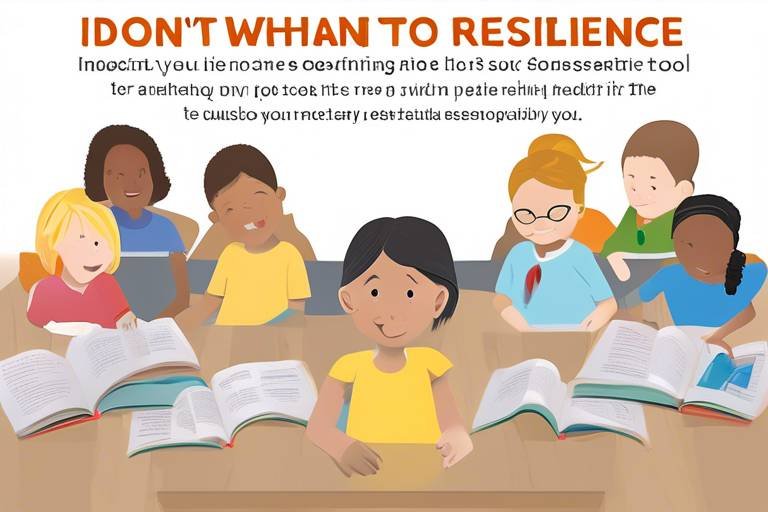How to Match Your Confidence Level with Your Skills?
Have you ever felt like you were on top of the world, brimming with confidence, only to realize that your skills didn’t quite match that feeling? It’s a common scenario, and it can be frustrating. The good news is that understanding the relationship between your confidence and your skills can lead to personal and professional growth. Imagine confidence as a bridge that connects your potential to your achievements. When both sides of the bridge are strong, you can traverse it with ease. But when there’s a gap, it can feel like you’re teetering on the edge. In this article, we’ll explore practical strategies to align your confidence with your skills, ensuring that you not only feel capable but also are capable of achieving your goals.
Confidence is not just a buzzword; it's a crucial component of success in every aspect of life. But what does it truly mean? At its core, confidence is the belief in your abilities and judgment. It’s that inner voice that says, “You’ve got this!” This belief can significantly influence your performance, whether you’re in a personal relationship or climbing the corporate ladder. Think of confidence as the fuel that powers your engine. Without it, even the most skilled individuals may struggle to reach their destination. When you’re confident, you’re more likely to take risks, embrace challenges, and pursue opportunities that can lead to growth.
Recognizing your skills is the first step toward aligning them with your confidence. It's like finding the right puzzle pieces that fit together to create a complete picture of your capabilities. But how do you identify these skills? Start by reflecting on your experiences and achievements. Ask yourself questions like: What tasks do I excel at? What do others often compliment me on? You might also consider using self-assessment tools or personality tests to gain insights into your strengths and areas for improvement. This clarity will provide a solid foundation for building your self-assurance.
Self-assessment techniques can help you evaluate your skills effectively. One popular method is the SWOT analysis, where you identify your Strengths, Weaknesses, Opportunities, and Threats. This structured approach allows you to see where your skills shine and where you might need to focus your efforts. Additionally, consider keeping a skills inventory—essentially a list of your abilities—that you can update as you grow. This living document serves as a reminder of what you bring to the table and can boost your confidence when you’re feeling uncertain.
Journaling can be a powerful tool for self-reflection. By documenting your skills and experiences, you create a narrative of your journey that enhances self-awareness. Each entry is a step toward understanding your capabilities better. For instance, note down challenges you’ve overcome, skills you’ve developed, and moments when you felt particularly confident. Over time, this record will not only highlight your growth but also serve as a motivational reminder of what you can achieve.
Feedback from others provides valuable insights into your skills. Don’t shy away from asking for constructive criticism from peers, mentors, or supervisors. This external perspective can illuminate strengths you may not recognize and highlight areas for improvement. When you receive feedback, approach it with an open mind. Remember, the goal is to grow, and sometimes that means facing uncomfortable truths. Use this information to refine your skills and bolster your confidence in those areas.
Setting achievable goals is essential for building confidence. Think of goals as stepping stones that lead you toward greater challenges. The SMART criteria—Specific, Measurable, Achievable, Relevant, Time-bound—can be your roadmap. For example, instead of saying, “I want to be better at public speaking,” you might set a goal like, “I will deliver a presentation at work within the next month.” This specificity not only makes your goal more tangible but also gives you a clear target to aim for, boosting your confidence as you progress.
Practice is key to developing both skills and confidence. Just like a musician perfects their craft through repeated play, you too need to engage in deliberate practice. This means focusing on specific areas for improvement and dedicating time to them consistently. The more you practice, the more competent you become, and naturally, your confidence will follow suit. It’s a cycle: skill development leads to increased confidence, which in turn motivates further practice.
Failure is often viewed negatively, but it can be a powerful teacher. Instead of fearing failure, embrace it as part of your learning process. Each setback is an opportunity to learn and grow. Remember, even the most successful people have faced failures along their journey. The key is to analyze what went wrong, adjust your approach, and try again. This resilience not only strengthens your skills but also builds a robust foundation of confidence.
Visualization can enhance performance and confidence. By mentally rehearsing success, you align your mindset with your skills. Picture yourself achieving your goals, whether it’s acing a presentation or mastering a new skill. This mental practice can reduce anxiety and increase your sense of preparedness. When you visualize success, you’re essentially programming your brain to believe that you can achieve it, which in turn boosts your self-assurance.
- How can I identify my skills? Reflect on your experiences and seek feedback from others to gain insights into your strengths.
- What if I feel overwhelmed by my goals? Break them down into smaller, manageable steps to make them less daunting.
- How do I handle criticism? Approach feedback with an open mind and view it as a chance to grow rather than a personal attack.
- Can visualization really help? Yes! Visualizing success can mentally prepare you for real-life situations, enhancing confidence.

Understanding Confidence
This article explores the relationship between confidence and skills, offering insights on how to align the two for personal and professional growth. Discover practical strategies to boost your self-assurance and capabilities.
Confidence is more than just a buzzword thrown around in self-help books; it is a crucial component of success in every aspect of life. Imagine walking into a room filled with strangers, your heart racing, palms sweating. Now, picture yourself striding in with your head held high, ready to engage. The difference? Confidence. It influences not only how we perceive ourselves but also how others perceive us. Whether it’s nailing a job interview, acing a presentation, or building personal relationships, confidence acts as the fuel that drives our performance.
So, what does confidence truly mean? At its core, confidence is the belief in your abilities and judgment. It’s that inner voice that whispers, “You’ve got this!” when faced with challenges. However, confidence is a double-edged sword; too little can lead to missed opportunities, while too much can result in overestimating our capabilities and facing unnecessary risks. Striking the right balance is essential.
In various aspects of life, from personal relationships to career advancement, confidence plays an integral role. For instance, in the workplace, a confident employee is more likely to take initiative, share ideas, and lead projects. Conversely, a lack of confidence can hinder performance and lead to self-doubt. This cycle can be vicious, as low confidence can lead to poor performance, which in turn reinforces the belief that one is not capable.
To truly understand confidence, it’s important to recognize that it is not a static trait. It fluctuates based on our experiences, environment, and even our mindset. Factors such as past successes, failures, and the feedback we receive from others can significantly impact our confidence levels. For example, receiving praise for a job well done can boost your self-esteem, while criticism can have the opposite effect. This is why it’s essential to cultivate a positive environment and surround ourselves with supportive individuals who uplift us.
Moreover, confidence can be categorized into two types: general confidence and specific confidence. General confidence refers to an overall sense of self-assurance, while specific confidence pertains to belief in one’s abilities in particular areas. For instance, you might feel confident in your social skills but lack confidence in your technical abilities. Understanding these nuances can help you identify where you need to focus your efforts to align your skills with your confidence.
In conclusion, confidence is a multifaceted concept that significantly influences our lives. By understanding its nature and the factors that affect it, we can take proactive steps to enhance our self-assurance. Remember, confidence is not just about feeling good; it’s about believing in your abilities and taking action. So, how can you start building that confidence today? Let’s explore some practical strategies in the following sections!
- What is the difference between confidence and self-esteem?
Confidence is about your belief in your abilities, while self-esteem relates to your overall sense of self-worth.
- Can confidence be learned?
Absolutely! Confidence can be developed through practice, positive reinforcement, and self-reflection.
- How can I boost my confidence quickly?
Engaging in positive self-talk, setting small achievable goals, and practicing mindfulness can help enhance your confidence in the short term.

Identifying Your Skills
Recognizing your skills is the first step toward aligning them with your confidence. It’s like finding the right puzzle pieces that fit perfectly to create a beautiful picture of your potential. But how do you even start identifying these skills? First off, it's essential to understand that skills can be both hard and soft. Hard skills are specific, teachable abilities like coding, accounting, or graphic design, while soft skills encompass personal attributes like communication, teamwork, and problem-solving. Each plays a vital role in shaping who you are and how you navigate through life.
One effective way to identify your skills is through self-reflection. Take a moment to think about what you enjoy doing and what comes naturally to you. Ask yourself questions like:
- What tasks do I find easy that others struggle with?
- What activities make me lose track of time?
- When have I received compliments about my abilities?
These reflections can illuminate your strengths and highlight potential areas for improvement. Another method is to engage in self-assessment techniques. Various tools, such as online quizzes and personality tests, can provide insights into your skills. These assessments can help you understand your capabilities in a structured way, offering a clearer picture of where you excel and where you might want to grow.
Self-assessment techniques can help you evaluate your skills effectively. Think of it as taking a magnifying glass to your abilities. You can use resources like the SWOT analysis (Strengths, Weaknesses, Opportunities, Threats) to get a comprehensive view of your skill set. Here’s a simple table to illustrate how this works:
| SWOT Analysis | Details |
|---|---|
| Strengths | What are your top skills? What do you do well? |
| Weaknesses | Where do you struggle? What skills do you lack? |
| Opportunities | What opportunities exist for you to improve? Where can you apply your skills? |
| Threats | What obstacles might hinder your progress? Are there skills you need to compete effectively? |
By filling out this table, you can create a roadmap for personal development that not only identifies your skills but also aligns them with your confidence levels. Remember, the goal here is not just to list what you can do but to understand how these skills interact with your self-assurance.
Another powerful tool for self-reflection is journaling. Keeping a skills journal allows you to document your experiences, successes, and even failures. This practice can enhance your self-awareness and boost your confidence over time. When you look back at your entries, you’ll see how far you’ve come and what skills you’ve developed along the way. It’s like writing your own success story, one page at a time.
Don’t underestimate the value of feedback from others. Sometimes, we’re too close to our own abilities to see them clearly. By soliciting constructive criticism from friends, family, or colleagues, you can gain valuable insights into your skills. Ask them questions like:
- What do you think I excel at?
- Where do you see room for improvement?
This feedback can serve as a mirror, reflecting your abilities in ways you might not have considered. Use this information to make adjustments and enhance your confidence in those areas.
In conclusion, identifying your skills is an ongoing journey. It requires introspection, the willingness to learn from others, and the courage to face both strengths and weaknesses. By actively engaging in self-assessment techniques, journaling, and seeking feedback, you can build a robust understanding of your abilities that will serve as a solid foundation for boosting your confidence.

Self-Assessment Techniques
Self-assessment techniques are essential tools that empower you to evaluate your skills effectively. They serve as a mirror, reflecting your strengths and areas for improvement. Think of self-assessment as a personal GPS; it helps you navigate your journey towards aligning your confidence with your abilities. By understanding where you currently stand, you can chart a course for growth and development.
One of the most effective methods of self-assessment is through skills inventories. These inventories are structured lists that prompt you to consider various skills and rate your proficiency in each. You can create your own inventory or find templates online that cater to your specific field. For instance, if you're in marketing, you might assess skills like SEO, content creation, and social media management. This process not only clarifies what you excel at but also highlights areas needing improvement.
Another powerful technique is self-reflection. Set aside time each week to ponder your experiences and performance. Ask yourself questions such as:
- What skills did I utilize effectively this week?
- Where did I struggle, and what can I learn from those challenges?
- How did I feel about my performance in various situations?
By regularly engaging in self-reflection, you create a habit of self-awareness, which is crucial for building confidence. You’ll start to notice patterns in your behavior and skills, which can inform your future learning and development strategies.
Additionally, consider using 360-degree feedback, where you gather input from peers, supervisors, and even subordinates. This comprehensive approach can provide you with a well-rounded view of your skills from multiple perspectives. It’s like having a team of navigators helping you see the bigger picture. Just remember, while feedback can be invaluable, it’s essential to approach it with an open mind and a willingness to grow.
Lastly, don’t underestimate the power of personality assessments. Tools like the Myers-Briggs Type Indicator (MBTI) or the StrengthsFinder can offer insights into your natural inclinations and talents. Understanding your personality can help you identify skills that align with your inherent strengths, making it easier to build confidence in those areas. It’s akin to discovering the right tools for your toolbox—once you know what you have, you can start to use them effectively.
In summary, self-assessment techniques are vital for anyone looking to enhance their confidence and skills. By utilizing skills inventories, engaging in self-reflection, seeking 360-degree feedback, and exploring personality assessments, you can gain a clearer understanding of your abilities. This clarity is the first step toward aligning your confidence with your skills, setting you up for personal and professional success.
Q: How often should I conduct a self-assessment?
A: It's beneficial to conduct a self-assessment at least once every few months, or whenever you feel a significant change in your skills or confidence.
Q: Can self-assessment really improve my confidence?
A: Absolutely! By understanding your skills and recognizing your growth areas, you can set realistic goals that enhance your self-assurance over time.
Q: What if I receive negative feedback?
A: Negative feedback can be tough to swallow, but it’s a valuable opportunity for growth. Use it to identify areas for improvement and develop a plan to address them.
Q: Are there specific tools I can use for self-assessment?
A: Yes! There are numerous online tools and resources available, including skills inventories, personality assessments, and feedback platforms.

Journaling Your Skills
Journaling your skills is more than just writing down what you can do; it's a pathway to self-discovery and personal growth. Imagine your skills as a garden; without proper care and attention, it can become overgrown with weeds or, worse, left to wither away. By documenting your skills, you not only cultivate awareness but also nurture the very abilities that contribute to your confidence.
When you take the time to journal, you're essentially creating a roadmap of your strengths and weaknesses. This process allows you to reflect on your experiences, recognize patterns in your learning, and identify areas that need improvement. The act of writing can be cathartic, transforming vague thoughts into concrete insights. Here are a few key benefits of journaling your skills:
- Enhanced Self-Awareness: By regularly noting your skills, you become more attuned to what you excel at and where you might need to grow.
- Tracking Progress: Journaling provides a tangible record of your development over time. You can look back and see how far you've come, which can be incredibly motivating.
- Clarifying Goals: As you document your skills, you may find clarity in what you want to achieve. This can lead to setting more focused and realistic goals.
To make the most of your journaling practice, consider the following strategies:
- Set a Regular Schedule: Consistency is key. Whether it's daily, weekly, or monthly, find a rhythm that works for you.
- Be Honest and Detailed: Write openly about your experiences, successes, and failures. The more detailed you are, the more insights you'll gain.
- Reflect on Feedback: Incorporate feedback from others into your journal. This will help you see your skills from different perspectives.
Incorporating journaling into your routine can be a game-changer. It's not just about listing skills; it's about weaving a narrative that connects your past experiences with your future aspirations. As you write, you may find that your confidence grows alongside your skills, creating a powerful synergy that propels you forward in both your personal and professional life.

Seeking Feedback
Seeking feedback is an essential step in the journey of aligning your skills with your confidence. It's like having a mirror that reflects not only your strengths but also areas that need improvement. But why is feedback so crucial? Well, feedback can provide insights that you might overlook. Sometimes, we are our own worst critics, and getting an external perspective can shine a light on our true capabilities.
When you actively seek feedback, you open the door to growth. Imagine you’re in a cooking class. You might think you’ve nailed the recipe, but your instructor might point out that your seasoning is off. That small piece of advice can transform your dish from mediocre to mouth-watering. Similarly, feedback can help you refine your skills and boost your confidence. However, it’s important to approach feedback with an open mind. Here are a few tips to consider when seeking feedback:
- Choose the Right People: Seek feedback from individuals who understand your field and have your best interests at heart. This could be colleagues, mentors, or even friends who are knowledgeable.
- Be Specific: When asking for feedback, be clear about what you want to know. Instead of a vague “What do you think?”, try asking “How can I improve my presentation skills?” This will yield more actionable insights.
- Listen Actively: When receiving feedback, listen without becoming defensive. Remember, the aim is to learn and grow. Take notes if necessary, and ask follow-up questions to clarify any points.
- Reflect and Act: After receiving feedback, take the time to reflect on it. What resonates with you? What can you implement right away? Use this feedback as a roadmap for your personal development.
Feedback isn’t just about receiving; it’s also about creating a culture of open communication. Encourage others to share their thoughts with you regularly. This not only helps you grow but also fosters a supportive environment where everyone feels comfortable sharing their insights. Remember, the goal is to cultivate a mindset that views feedback as a stepping stone rather than a stumbling block.
Incorporating feedback into your routine can be transformative. It allows you to build a solid foundation of self-awareness. As you become more attuned to your strengths and weaknesses, your confidence will naturally start to rise. So, don’t shy away from seeking feedback; embrace it as a valuable tool in your personal and professional toolkit.
1. Why is feedback important for building confidence?
Feedback provides external validation of your skills and highlights areas for improvement. This insight is crucial for building a realistic self-assessment and enhancing your confidence.
2. How can I ask for feedback without feeling awkward?
Frame your request positively and be specific about what you want to improve. Most people appreciate being asked for their opinion and will likely be happy to help.
3. What should I do if I receive negative feedback?
Take a moment to process it. Remember that negative feedback is not a reflection of your worth but an opportunity for growth. Reflect on the insights and consider how you can use them to improve.
4. How often should I seek feedback?
Regular feedback is beneficial. Aim to seek it after completing significant tasks or projects, or set a routine to ask for feedback monthly or quarterly.

Setting Realistic Goals
Setting realistic goals is a cornerstone of building confidence and aligning it with your skills. When we talk about goals, we're not just throwing darts in the dark; we need to aim for specific targets that are achievable yet challenging. Think of it like climbing a mountain. You wouldn't just leap to the summit; instead, you would plan your ascent, step by step. By setting SMART goals—Specific, Measurable, Achievable, Relevant, and Time-bound—you create a roadmap that guides your journey toward self-improvement.
Consider this: when your goals are clear and attainable, you’re more likely to stay motivated and engaged. It’s like having a compass that directs you through the fog of uncertainty. For example, instead of saying, "I want to be better at public speaking," you could set a goal like, "I will join a local Toastmasters club and give a speech every month for the next six months." This approach not only makes your goal specific but also measurable and time-bound, which is crucial for tracking your progress.
Moreover, breaking down larger goals into smaller, manageable tasks can significantly enhance your confidence. For instance, if your ultimate goal is to get a promotion at work, you can segment this into smaller objectives, such as:
- Completing a relevant certification course within three months.
- Seeking mentorship from a senior colleague.
- Requesting feedback on your performance quarterly.
By accomplishing these smaller tasks, you’ll gradually build the confidence needed to tackle the larger goal. Each success, no matter how small, acts as a building block for your self-assurance.
Additionally, it's essential to remain flexible with your goals. Life is unpredictable, and sometimes you may need to adjust your targets based on new circumstances or insights. This doesn’t mean you’re giving up; rather, you’re adapting, which is a vital skill in both personal and professional growth. Remember, the journey of self-improvement is not a straight line but a winding road filled with opportunities for learning and growth.
In conclusion, setting realistic goals is not just about achieving success; it’s about creating a sustainable path that nurtures your confidence and skills. By being intentional about your objectives and allowing yourself the grace to adapt, you’ll find that the alignment of your confidence and skills becomes not just a possibility but a reality.
Q: What are SMART goals?
A: SMART goals are Specific, Measurable, Achievable, Relevant, and Time-bound objectives that help you create a clear roadmap for success.
Q: How do I know if my goals are realistic?
A: A goal is realistic if it is achievable within your current skill set and resources, while still pushing you to grow. Consider your past experiences and feedback from others to gauge realism.
Q: Can I adjust my goals after setting them?
A: Absolutely! Flexibility is key in goal setting. Life changes and new opportunities may require you to adjust your goals to better align with your current situation.
Q: How often should I review my goals?
A: Regular reviews, such as monthly or quarterly, can help you stay on track and make necessary adjustments. This practice keeps your goals fresh and relevant.

Building Confidence Through Practice
When it comes to building confidence, one of the most effective methods is through practice. Just like a musician perfects their craft by playing their instrument daily, you too can enhance your skills and boost your self-assurance through consistent effort. Think of practice as the bridge that connects your current abilities to your desired level of confidence. The more you engage in deliberate practice, the more you learn, grow, and ultimately feel confident in your capabilities.
So, what does deliberate practice entail? It’s not just about putting in hours; it’s about focusing on specific areas where you want to improve. For instance, if you’re looking to enhance your public speaking skills, practicing in front of a mirror or recording yourself can provide insight into your performance. This approach allows you to identify areas for improvement, such as body language or pacing, which can significantly affect your confidence level when speaking in front of an audience.
Another key aspect of building confidence through practice is to embrace the process. Understand that mastery doesn’t happen overnight. Just like a caterpillar transforms into a butterfly, your journey will have its ups and downs. Here are a few points to consider:
- Consistency is Key: Make practice a regular part of your routine. Whether it’s daily or weekly, consistency breeds familiarity and comfort.
- Set Incremental Challenges: Gradually increase the difficulty of your practice sessions. This will help you push your boundaries without feeling overwhelmed.
- Reflect on Your Progress: Take time to evaluate how far you’ve come. Celebrating small victories can significantly enhance your overall confidence.
Moreover, it's vital to remember that failure is not the end but rather a stepping stone toward success. Each mistake you make during practice is an opportunity to learn and improve. By reframing your perspective on failure, you cultivate resilience and a growth mindset. This shift not only enhances your skills but also solidifies your confidence. Think of it this way: every great athlete has faced setbacks, yet they continue to train and refine their abilities, emerging stronger than before.
Visualization techniques can also play a significant role in building confidence through practice. Picture yourself succeeding in your endeavors. Imagine how it feels to deliver a flawless presentation or to perform a challenging task with ease. This mental rehearsal can help you align your mindset with your skills, making the actual performance less daunting. Consider setting aside time during your practice sessions to visualize your success, allowing your brain to create a mental blueprint of achievement.
In conclusion, building confidence through practice is a dynamic and ongoing process. By committing to consistent practice, embracing failure as a learning tool, and employing visualization techniques, you can significantly enhance your self-assurance. Remember, confidence is not an innate trait; it’s a skill that you can develop over time. So, roll up your sleeves, put in the work, and watch as your confidence grows alongside your skills.
Q: How long does it take to build confidence through practice?
A: The time it takes to build confidence varies from person to person. Consistency and dedication to practice will lead to gradual improvements over time.
Q: Can visualization really help improve my confidence?
A: Yes! Visualization is a powerful technique that can help you mentally prepare for challenges, making you feel more confident when the time comes to perform.
Q: What if I fail during practice?
A: Failure is a natural part of the learning process. Instead of viewing it negatively, use it as an opportunity to learn and grow. Each failure can bring you one step closer to success.

Embracing Failure
When it comes to personal and professional growth, failure is often seen as a setback, but what if we flipped the script? Instead of fearing failure, what if we embraced it? Imagine failure as a stepping stone rather than a stumbling block. Each misstep can serve as a valuable lesson, guiding us toward greater self-awareness and improved skills. The truth is, everyone faces failure at some point; it's a universal experience that connects us all.
Think about it: every successful person you admire has faced their fair share of failures. They didn’t achieve greatness overnight. They stumbled, learned, and grew from their experiences. By embracing failure, we allow ourselves to take risks without the paralyzing fear of making mistakes. This shift in mindset can be liberating, opening up a world of possibilities.
So, how do we go about embracing failure? Here are a few strategies:
- Change Your Perspective: Instead of viewing failure as a negative outcome, see it as a learning opportunity. Ask yourself what you can learn from the experience. Each failure can provide insights that can enhance your skills.
- Practice Resilience: Building resilience is key. When you face setbacks, remind yourself that it's part of the journey. Resilience helps you bounce back stronger and more determined.
- Share Your Experiences: Talking about your failures with others can help normalize the experience. You’ll find that many people have faced similar challenges, and sharing can foster a sense of community and support.
Embracing failure doesn’t mean you won’t feel disappointed or frustrated; it means you’re willing to acknowledge those feelings and move forward. Each time you pick yourself up after a fall, you’re strengthening your confidence and reinforcing your skills. It’s like building muscle; the more you lift, the stronger you become.
Moreover, failure can ignite your passion. When you encounter obstacles, it often pushes you to dig deeper and explore new avenues. This exploration can lead to unexpected discoveries about your capabilities and interests. In essence, failure can act as a catalyst for growth, helping you align your confidence with your skills.
In conclusion, embracing failure is not just about accepting mistakes; it’s about leveraging them to fuel your journey toward success. By shifting your mindset, practicing resilience, and sharing your experiences, you can transform failures into powerful tools for growth. Remember, every failure is just a stepping stone on the path to achieving your goals.
- How can I shift my mindset about failure?
Start by reframing your thoughts. Instead of seeing failure as the end, view it as a learning opportunity. Journaling your thoughts after a failure can also help you process the experience. - What are some practical ways to deal with failure?
Practice self-compassion, seek feedback, and focus on the lessons learned. Engaging in supportive conversations with friends or mentors can also be beneficial. - Can failure really lead to success?
Absolutely! Many successful individuals attribute their achievements to lessons learned from past failures. Each setback can provide invaluable insights that contribute to future success.

Visualization Techniques
Visualization techniques are more than just daydreaming; they are powerful tools that can significantly enhance your performance and confidence. Imagine standing before an audience, your heart racing as you prepare to deliver a presentation. Now, picture yourself not just standing there, but doing so with absolute poise and assurance. This is the essence of visualization—mentally rehearsing success to align your mindset with your skills.
To effectively utilize visualization techniques, it's essential to engage all your senses. Close your eyes and vividly imagine the scenario you wish to excel in. What do you see? What do you hear? How do you feel? The more detailed your mental imagery, the more impactful it will be. This method can be applied to various situations, such as public speaking, sports performance, or even everyday tasks like job interviews.
Here's how you can incorporate visualization into your routine:
- Set aside time: Dedicate a few minutes each day to practice visualization. It could be in the morning before you start your day or at night when you're winding down.
- Create a mental movie: Imagine yourself successfully completing a task. Visualize every detail, from the environment to the reactions of others.
- Focus on positive outcomes: Instead of picturing what could go wrong, concentrate on the positive aspects and the feelings of achievement.
Research has shown that visualization can lead to improved performance. Athletes often use this technique to prepare for competitions, mentally rehearsing their routines to enhance muscle memory and boost confidence. But it’s not just for athletes; anyone can benefit from visualization. Whether you’re preparing for a big meeting or trying to ace an exam, visualizing your success can help solidify your self-assurance.
Moreover, visualization can also serve as a form of motivation. When you see yourself achieving your goals in your mind, it creates a powerful drive to make those visions a reality. It’s like having a personal cheerleader in your head, urging you to push through challenges and believe in your capabilities. So, why not give it a try? The next time you’re facing a daunting task, take a moment to visualize your success. You might be surprised at how much it can elevate your confidence and performance.
In conclusion, visualization techniques are a simple yet effective way to align your confidence with your skills. By practicing visualization regularly, you can create a mental framework that not only prepares you for success but also reinforces your belief in your abilities. So, close your eyes, picture your goals, and watch as your confidence soars!
Q: How often should I practice visualization?
A: It's beneficial to practice visualization daily, even if just for a few minutes. Consistency helps reinforce the mental images you create.
Q: Can visualization replace actual practice?
A: While visualization is a powerful tool, it should complement actual practice. Combining both techniques will yield the best results.
Q: What if I struggle to visualize?
A: If you find it difficult to visualize, start with guided imagery exercises or consider using apps designed to aid in visualization.
Frequently Asked Questions
- What is the relationship between confidence and skills?
Confidence and skills are intertwined; having the right skills can boost your confidence, while high confidence can motivate you to develop new skills. When both are aligned, you can tackle challenges more effectively and achieve personal and professional growth.
- How can I identify my strengths and weaknesses?
Identifying your strengths and weaknesses involves self-reflection and assessment. You can use self-assessment tools, seek feedback from peers, or even engage in journaling to gain insights into your abilities. This process helps you understand where you excel and where you might need improvement.
- What are SMART goals, and how can they help me?
SMART goals are Specific, Measurable, Achievable, Relevant, and Time-bound. By setting SMART goals, you can create a clear roadmap for your personal development, ensuring that your objectives are realistic and attainable, which in turn boosts your confidence as you achieve them.
- Why is practice important for building confidence?
Practice is essential because it helps you refine your skills and gain mastery over them. The more you practice, the more confident you become in your abilities. It’s like training for a sport; consistent practice leads to improved performance and greater self-assurance.
- How can I handle failure positively?
Embracing failure as a learning opportunity is key. Instead of viewing it as a setback, consider it a stepping stone toward growth. Analyze what went wrong, learn from the experience, and use that knowledge to improve your skills and confidence moving forward.
- What visualization techniques can enhance my confidence?
Visualization techniques involve mentally rehearsing success. Picture yourself achieving your goals, feel the emotions associated with that success, and visualize the steps you took to get there. This practice can significantly boost your confidence and prepare you for real-life situations.



















